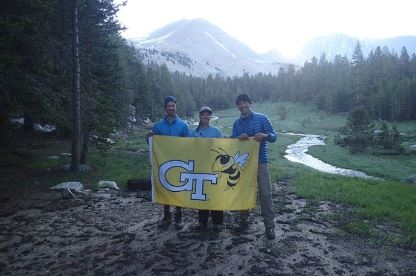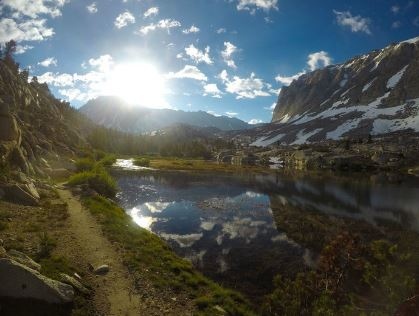THROWBACK THURSDAY: MEMBERS IN MOTION (SAM CHANELES)
 Picture this. No shoes, no socks, no pants.
Picture this. No shoes, no socks, no pants.And 50 miles of snow ice, rock, dirt, and mud ahead of me.
Last summer my father and I set out on a grand adventure. Over the course of 20 days and 220 miles, we planned to hike the famous John Muir Trail in the Sierra Nevada Mountains of California---a bucket list item for countless backpackers. 2017, however, was a unique year for undertaking this pursuit because California experienced one of the largest snowfalls in its history. Mammoth Mountain, which was located only a few miles from the trail, received over 500 inches of snow alone...That is over 41 feet!
We put in countless hours together preparing in the gym. We became champions of the StairMaster. We read countless articles, participated in forums, and studied gear lists from past hikers. We went on a training trip together to the Great Smoky Mountains one weekend, testing out our gear, working out food rations, and getting in some preliminary miles. Finally, we were ready to hit the John Muir Trail and put our training to the test.
June 18, 2017: We started our adventure out of Yosemite Valley, climbing up, up, and up.
The first few miles of the hike were crowded with other hikers exploring Yosemite Valley for the day. But as we continued climbing, we began to encounter snow and the number of our hiking companions plummeted to zero. Suddenly, it was just us. Alone in the mountains. Patchy snow quickly turned into miles upon miles of endless snowpack, blanketing the ground in an icy bluish white. This was not the pearly white snowfall on Christmas Eve in the backyard with hot cocoa waiting inside. This was a rotten and uneven mixture of ice, snow, and water. Inch after inch, foot after foot, we slowly made our way through the snow down into Tuolumne Meadows, a normally overcrowded area of Yosemite National Park that is renowned for its climbing locations. But the snow had turned it into a barren wasteland with no one else in sight.
As the day ticked on, we came across the first river that we would need to cross. With the water coming up to our knees, I decided our best bet was to take off our heavy duty boots before we crossed the river in order to keep them dry. So we put on our Crocs and began to wade into the water. Before we got too far, I decided it would be wise to toss my boots across the river and cross without them instead of carrying them in my hands or securing them to my pack. In my mind, I thought it made good sense because I would have my hands free to balance myself against the current and I would not risk the boots getting wet if I happened to slip and fall in the river. Now, science has proven that the frontal lobe---which governs judgment and decision making---does not fully develop until the age of 25 for most adults. I proved that theory fully in the following few minutes when I acted upon my "great idea."
I took off my socks and pants, wanting to keep them dry, and stuffed them into my left boot. I surveyed up and down the river bank for the perfect spot to throw my boots across. I walked up about 50 yards and then back down 75 yards. Finally, I located the perfect spot for me to aim at. Being a pitcher in high school, I was not just going to toss these boots across the river, granny-style. No. I was going to deliver a 95 mph fastball straight down the middle. World Series Game 7 style. Batter up! I was ready to deliver the pitch. I took my right boot, got into my windup stance, and let the boot fly .. only to watch it, almost in slow-motion, bounce directly off a tree straight in front of me and get swept up into the river. Without thinking, I dropped everything else I had in my arms and ran after that boot. My backpack still on, I dove into the river, desperately swimming after the slowly sinking shoe. With a final paddle, I reached its lace...Victory! I swam across the river back to the safety of the bank---wet, out of breath, and in utter shock at what had just happened. My dad shot me a look that said: "Whew! That was a close one." We shared a chuckle as I dried off on the river bank.
After a few peaceful moments, my dad exclaimed out of nowhere: "Wait, Sam! Where's your other boot?" And that's when it hit me. When I dove after my left boot, I had dropped everything I'd been carrying, including my right boot, which had happened to contain my balled up socks and pants, if you'll remember. The river had carried the left boot and its precious cargo right on down the river, never to be seen again.
So there I was, sitting on this river bank in the middle of the Sierra Nevada, alone with only my father and with only one boot. No pants. No socks. And 50 miles of snow-covered terrain ahead of me until the next town. I had a lot to think about. How could I possibly be this stupid? What had I gotten myself into? Was this cause for panic? How was I going to manage this situation? There were one million ways I could have freaked out, thrown a tantrum, and just made everything worse. I chose the million and first option: BREATHE.

I let out one primal yell, just to get it out of my system, and then I got down to business. I drew on the knowledge I had learned in my experience with Outdoor Recreation Georgia Tech (ORGT), where I often handled emergency situations in the backcountry with limited time, resources, and people to help. I analyzed what I had available, thought through different scenarios, and brainstormed best options with my dad. I also messaged my mom via our satellite messenger device that I needed her to mail me a package with a new pair of boots to the next town. I was expecting her to respond with: "Of course honey, no problem. Hope you and Dad are having a good time!" What I got in response was: "Why do you need boots?! Explain now!" The stress mounted, but still, we got ready to start hiking again.
LEARNING SPOTLIGHT:
Over the course of the next 50 miles, I hiked in Crocs with crampons strapped on over snow, ice, rocks, mud, and dirt. In the thick of those moments, in the middle of that chaos, I was able to reflect on what I had learned with ORGT and use it to push through what seemed like overwhelming obstacles. ORGT had not just taught me how to tie a bowline knot or how to make a fire, or how to pitch a tent. No, it taught me life skills: problem solving, risk mitigation, and effective communication. Leading backpacking trips into the Southeast had taught me how to effectively manage the needs of a group, think on my feet when challenges present themselves, and make the best of situations in which resources are scarce. And in the middle of Yosemite National Park, when I was alone, wet, cold, and hungry, I was able to think back to those life skills and somehow make it to the end of my trek with my dad despite all odds.
*Article was authored by Member Sam Chaneles and first published in the 2018 Spring Issue of AORE's Association News publication.